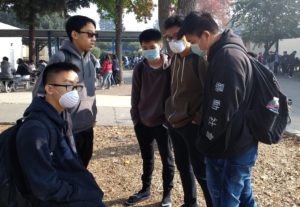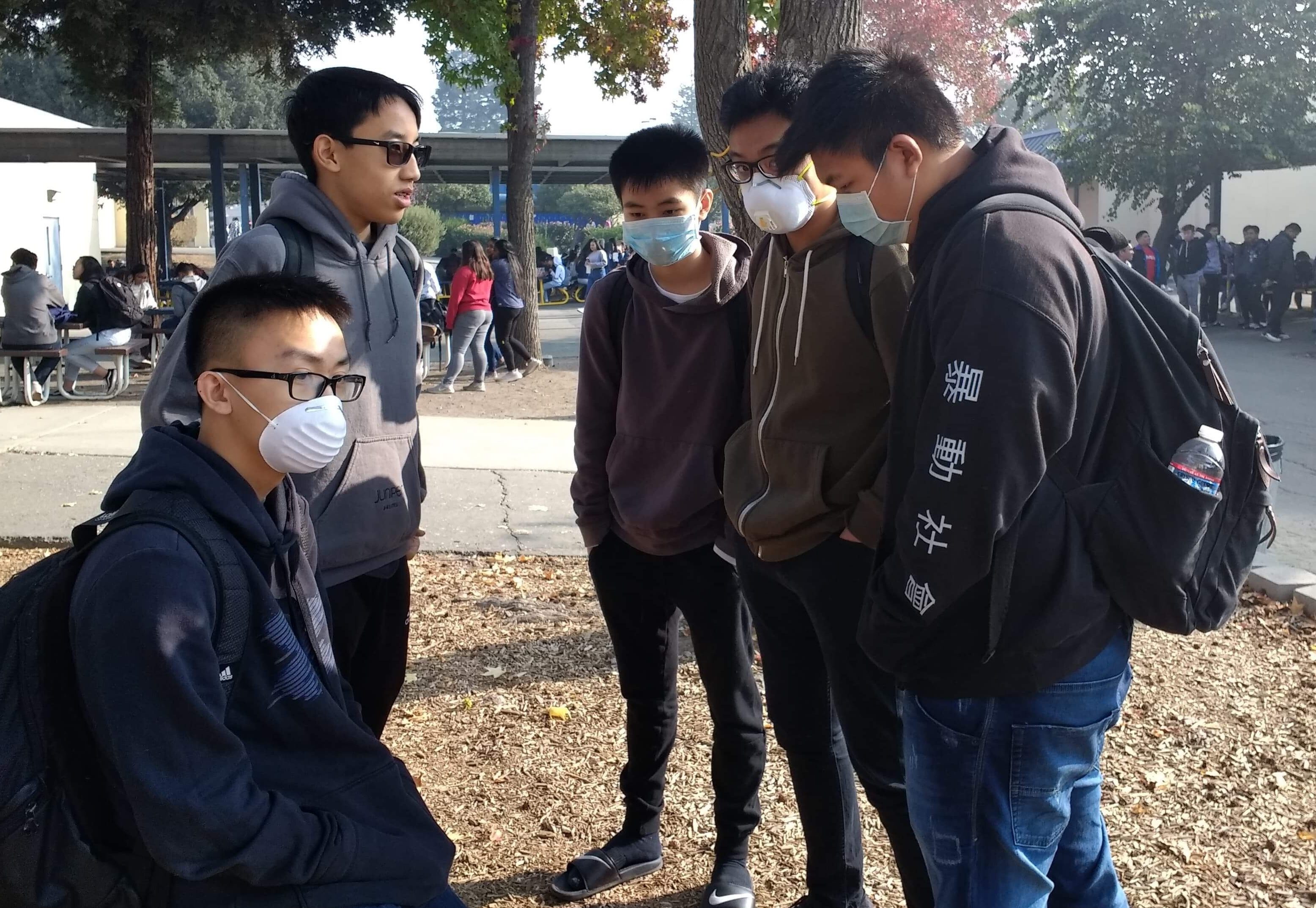
From left to right, Juniors William Nguyen, Jonathan Do, Andrew Nguyen, Geno Aldana, and Lance Ho gather during break while wearing face masks due to the unhealthy air.
By: Paul Chon, Alexander Phan
MHS closed Monday, Nov. 19, and Tuesday, Nov. 20, due to air quality, according to an email interview with Superintendent Cheryl Jordan. The decision was made in the best interest for students, parents, and staff, Jordan said.
A survey was sent out to get feedback from parents on Saturday, Nov. 17, Jordan said. Then, the decision to close MHS was made on Sunday, Nov. 18, Jordan added.
“There were two primary points of data that emerged, and that greatly influenced the decision [to close school],” Jordan said in an email. “The two data points were this: 92% of the 2,084 parent respondents said they preferred to keep their children at home if the AQI remained ‘unhealthy.’ [and] 17 of the staff respondents indicated that in the portable classrooms the air quality was not good, and in two of them, they could see a haze.”
Principal Francis Rojas did not have a huge role in making the decision to close the school, according to him. However, Rojas still supported the decision to close MHS, he said.
“The decision really was made at a county level, so my role with the superintendent in making decisions for our district was more like a consult,” Rojas said. “The extent of my involvement was responding to our concerns [and] me voicing the concerns to the superintendent.”
The school made a reasonable decision in closing school for the two days, Sophomore Harry Leung said. The survey the district sent out was a good way to gauge public opinion, but it was not enough, he added.
“The district handled the situation pretty well in my opinion, but they could have done more to listen to students’ and parents’ opinions,” Leung said. “To be honest, at least they let people know in the email that calling in sick to avoid the air was an option, so in the end, everything was handled pretty well.”
Since the district cancelled two days of school, the district will have to make up the missed time with additional days of school, Rojas said. The school has explored many options to make up the missed days, Rojas added.
“We have to have a 180 days of school and every day of school has to be a certain amount of minutes,” Rojas said. “So, the thing is elementary and middle schools have less required minutes. The high school has the most required minutes and this is Statewide. So, a 180 days is the minimum days of school that students are in school for at least half a day.”
A waiver to shorten school from 180 days to 179 days has been sent to the California Department of Education, Jordan said. If the waiver gets denied, MUSD will try to hear back from the California Department of Education in three months, Jordan said.
“The Board took action at its Nov. 27th meeting to have school on March 29, 2019 (Cesar Chavez Day) and to designate Tuesday, Nov. 20th the local holiday instead as that is right before Thanksgiving,” Jordan said in an email. “For the closed day on Nov. 19th, the last day of school will be June 7th.”
Some parents won’t see the air as a problem until they know for certain that the air is affecting the students, Junior Kimberly Ly said. So, parents will only allow their children to stay home if they get a notice from the school, Ly added.
“I do think that the mass email the superintendent sent out should’ve at least been worded better [and] to generalize most students’ home life and situation is not exactly ideal,” Ly said. “As high school students, most of us know how to handle an emergency without help of an adult. To say that [the administration] went one step further is not accurate at all. They didn’t ask for the students opinion at all even though we’re the ones mostly affected by it.”
Rojas sent out emails with guidelines for the sports teams to follow, he said. However, some sports did not follow directions outlined in the emails he sent out, Rojas said.
“We set down rules,” Rojas said. “[For example,] if it’s not below 150, you’re not outside. Maybe you can just stay inside and do the weight room or something, so we did set some parameters around that.”
Lamb was told to have modified activities if it was under an Air Quality Index level of 150, he said. However, an AQI level of 150 was not written anywhere as a standard, so no one had a good understanding of the standard, Lamb said.
“It would be really nice if there could be some type of standard out there so that people know [what to do],” Lamb said. “I think from a competitive standpoint most coaches [and] most athletic directors would like to say, ‘Okay, this is the same for everybody.’ [For example], if we don’t practice, then Piedmont Hills who has the same conditions is not practicing. So, everybody is in the same boat when it comes to that situation.”
Lamb had more work to do because of school closing down Monday and Tuesday,he said. Also, not knowing that the school was closing until Sunday night created a bigger workload, Lamb said.
“[Everything] was just a matter of logistics and we had to worry about the whole week because we didn’t know what it was going to be like,” Lamb said. Later he said, “I can’t just wait till Tuesday for Tuesday and Wednesday for Wednesday. We started to have to make some adjustments for that. That’s just the nature of the job. Things like that come up all the time.”
AP Government Teacher Michael Cummins wished that the decision to close MHS would have been announced sooner, he said. He wanted more time to plan on how to make up the two days, Cummins said.
“I’m mostly mad that we have these two days hanging over our head that we’re going to have to make up some time,” Cummins said. “I don’t like that, I don’t like chance. I want my schedule locked in, but what are you going to do? [Also, closing school] was especially hard for AP teachers who had [their] schedules down to the hour.”
The school could have handled the situation better, Varsity Soccer Player Nicholas Ngo said. For example, the school already knew of the bad air quality and that it was going to get worse, so they could have closed school on Thursday, Nov. 15, and Friday, Nov. 16, Ngo said.
“[Not closing school] just put the student’s health at risk,” Ngo said. “[Also,] I wasn’t keen on practicing my sport in the bad air quality because my team and I practice outside all the time and it requires us to do more heavy breathing and with the bad air quality was very unhealthy for us to continue training.”
School didn’t close on Thursday, Nov. 15, and Friday, Nov. 16, Jordan said. The decision to keep school open on Thursday and Friday was a decision based on guidelines meant to keep MUSD’s students and staff safe, Jordan said.
“I consulted with a group of Santa Clara County superintendents including the SCCOE Supt. Dr. Dewan who spoke with the Santa Clara County Health Department Health Officer, Dr. Sara Cody,” Jordan said in an email. “We determined that we would follow the guidelines for keeping students and staff safe by limiting outdoor exposure as much as possible. I did speak with our board members, and ultimately, I determined we would be safe following the guidelines that the SCC Health Dept. and Environmental Protection Agency described.”
Funding purposes had nothing to do with not closing school Thursday, Nov. 15, and Friday, Nov. 16, Santa Clara County Superintendent Dr. Mary Ann Dewan said. Schools provide shelter, food, medical care, and other services, Dewan said.
“The decision [not to close school] was made jointly by the County of Education and the school district superintendents in each of our 31 public school districts after consultation with the Santa Clara County Public Health Department,” Dewan said. “The decision was made jointly also after studying the air quality guidance and studying a number of documents related to children’s health and air quality. We are very concerned about the current air quality and safety of our students. The safety of our students is our number one priority.”
Junior Nicholas Agleham was not bothered by the school closing, he said. Agleham also thought that the decision to close school was something normal that the school should do, he said.
“Although the situation caused upsetting emotions from some students and families, I feel the school did a good job handling the situation, and the only big improvements I would’ve liked would be if the school asked for our opinions earlier,” Agleham said. “[Also,] I think the school did the best they could during school hours by instructing staff to keep rooms open to students if possible.”
Junior Christina Tuazon was displeased with the school’s decision to keep school open on Thursday, Nov. 15, and Friday, Nov. 16, she said. Tuazon said that the lack of action from the school was a senseless idea.
“When the school board had decided to take things a step further, I was dumbstruck,” Tuazon said. “I assumed they would consider that parental guardians would plan what to do for their children if school had been cancelled. I felt their decision to be ill-advised, considering the health consequences of the air quality.”

